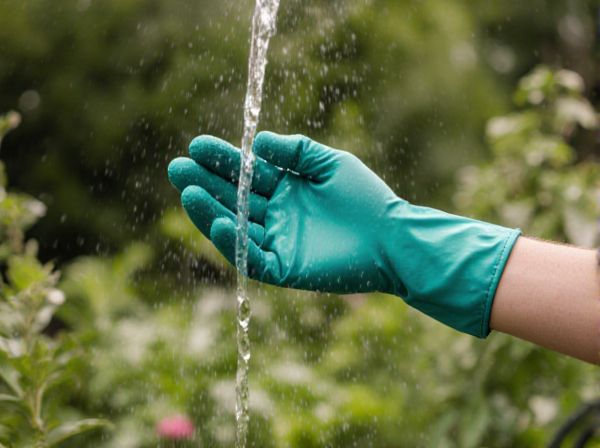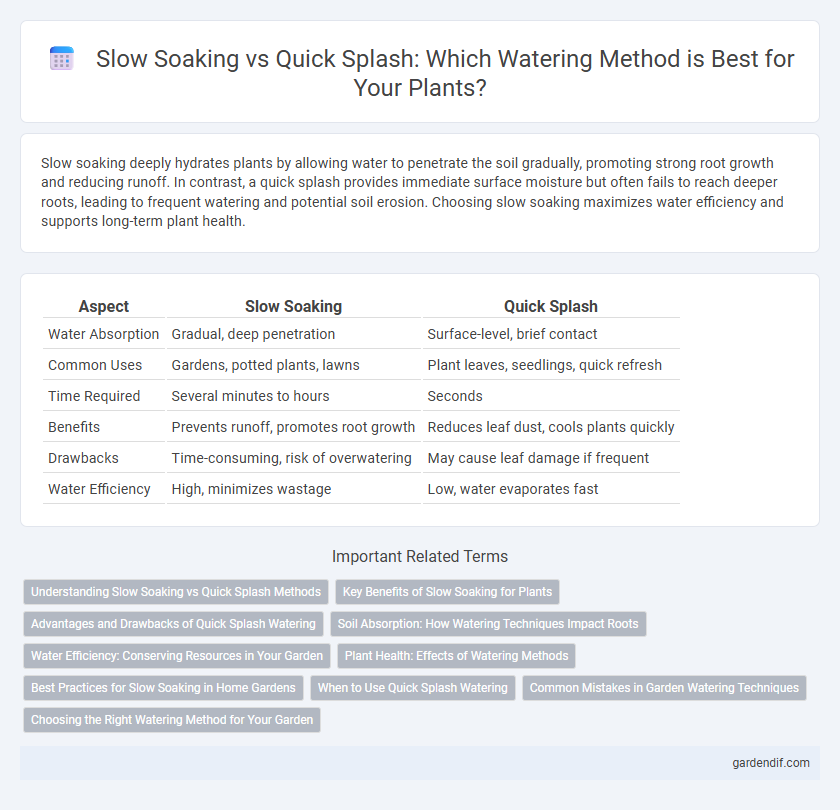
Slow soaking vs Quick splash Illustration
Slow soaking deeply hydrates plants by allowing water to penetrate the soil gradually, promoting strong root growth and reducing runoff. In contrast, a quick splash provides immediate surface moisture but often fails to reach deeper roots, leading to frequent watering and potential soil erosion. Choosing slow soaking maximizes water efficiency and supports long-term plant health.
Table of Comparison
| Aspect | Slow Soaking | Quick Splash |
|---|---|---|
| Water Absorption | Gradual, deep penetration | Surface-level, brief contact |
| Common Uses | Gardens, potted plants, lawns | Plant leaves, seedlings, quick refresh |
| Time Required | Several minutes to hours | Seconds |
| Benefits | Prevents runoff, promotes root growth | Reduces leaf dust, cools plants quickly |
| Drawbacks | Time-consuming, risk of overwatering | May cause leaf damage if frequent |
| Water Efficiency | High, minimizes wastage | Low, water evaporates fast |
Understanding Slow Soaking vs Quick Splash Methods
Slow soaking involves applying water gradually over an extended period to deeply penetrate soil and promote root growth, whereas quick splash delivers a rapid, shallow amount of water that primarily wets the surface. Slow soaking minimizes runoff and soil erosion, improving water retention and nutrient absorption for plants. Quick splash is best suited for light watering needs but can cause water waste and ineffective root hydration if used excessively.
Key Benefits of Slow Soaking for Plants
Slow soaking enhances deep root hydration by allowing water to penetrate soil layers gradually, reducing runoff and nutrient loss. This method improves soil aeration and microbial activity, fostering stronger plant growth and resilience. Plants benefit from sustained moisture levels, which minimize stress during dry periods.
Advantages and Drawbacks of Quick Splash Watering
Quick splash watering delivers immediate hydration to plant surfaces, reducing evaporation loss and providing rapid moisture for shallow root growth. This method conserves time and water in arid conditions but risks uneven soil penetration and increased runoff, potentially causing soil erosion and nutrient leaching. Fast application is suitable for drought-resistant plants but may stress deep-rooted species needing thorough soil soaking.
Soil Absorption: How Watering Techniques Impact Roots
Slow soaking enhances soil absorption by allowing water to penetrate deeply, promoting healthier root growth and reducing runoff. Quick splash watering often results in surface saturation with minimal infiltration, leading to weaker roots and potential soil erosion. Optimizing watering techniques to maximize soil absorption ensures sustained moisture availability and stronger plant development.
Water Efficiency: Conserving Resources in Your Garden
Slow soaking optimizes water efficiency by deeply penetrating the soil, reducing runoff and evaporation, which conserves water resources essential for sustainable gardening. Quick splash watering often wastes water through surface runoff and minimal absorption, leading to frequent re-watering and higher water consumption. Prioritizing slow soaking techniques enhances soil moisture retention, promotes healthier plant roots, and supports eco-friendly water management practices.
Plant Health: Effects of Watering Methods
Slow soaking allows deeper soil penetration, promoting robust root growth and improving drought resistance by ensuring water reaches the root zone effectively. Quick splash watering often wets only the surface, potentially causing shallow roots and increasing vulnerability to dry conditions and soil erosion. Consistent slow soaking supports healthier plants by maintaining optimal moisture levels and reducing stress.
Best Practices for Slow Soaking in Home Gardens
Slow soaking allows water to penetrate deeply into the soil, promoting healthier root development and reducing surface runoff in home gardens. Using soaker hoses or drip irrigation ensures even water distribution while minimizing evaporation loss compared to quick splash watering methods. Maintaining consistent moisture levels with slow soaking encourages robust plant growth and conserves water resources effectively.
When to Use Quick Splash Watering
Quick splash watering is ideal for rapidly hydrating plants in dry, hot conditions where immediate moisture absorption is critical to prevent wilting. It efficiently delivers a swift burst of water to the surface, suitable for established plants with shallow root systems or during early morning when water evaporation rates are lower. Using quick splash watering helps maintain soil moisture without waterlogging, making it advantageous for delicate seedlings and plants prone to root rot.
Common Mistakes in Garden Watering Techniques
Slow soaking ensures deep soil penetration, preventing water runoff and promoting healthy root growth, while quick splash watering often leads to surface runoff and inadequate hydration. Common mistakes include watering too quickly, causing erosion and wasting water, or too infrequently, leading to dry, stressed plants. For optimal garden health, use slow soaking techniques during early morning or late evening to maximize absorption and minimize evaporation.
Choosing the Right Watering Method for Your Garden
Slow soaking delivers deep hydration by allowing water to penetrate soil gradually, promoting strong root growth and reducing runoff. Quick splash watering may be suitable for light surface moisture needs but often leads to evaporation and inefficient water use. Selecting the proper watering method depends on soil type, plant species, and moisture requirements to optimize garden health and conserve water.
Slow soaking vs Quick splash Infographic

 gardendif.com
gardendif.com